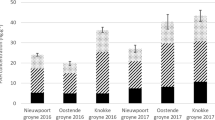Abstract
Elimination rate constants (k 2), biological half-lives (t1/2), and the time required to reach 95% of steady-state (t 95) are reported for 46 individual polycyclic aromatic hydrocarbons (PAHs) including both parent and alkyl homologues, for the freshwater unionid mussel, Elliptio complanata. Elimination rate constants generally follow first-order kinetics and range from 0.04/day (d) for perylene to 0.26/d for 2,6-dimethylnapthalene, half-lives range from 2.6 to 16.5 d, and t 95 values range from 11.3 to 71.3 d. These values compare well with other k 2, t 1/2, and t 95 values reported in the literature for PAHs and other classes of hydrophobic organic contaminants. A linear regression of k 2 versus logK ow demonstrates dependence of PAH elimination on hydrophobicity, as measured by an r 2 value of 0.83, and produces the following regression equation: k 2 = −0.06 (logK ow) + 0.44. This study provides evidence that mussels experiencing different forms of physiological stress (e.g., handling stress and fungal or bacterial growth) can exhibit large variation in toxicokinetic parameters. These results are particularly relevant to the extrapolation of laboratory results to field situations.
Similar content being viewed by others
Author information
Authors and Affiliations
Rights and permissions
About this article
Cite this article
Thorsen, ., Forestier, ., Sandifer, . et al. Elimination Rate Constants of 46 Polycyclic Aromatic Hydrocarbons in the Unionid Mussel, Elliptio complanata . Arch Environ Contam Toxicol 47, 332–340 (2004). https://doi.org/10.1007/s00244-004-3186-y
Issue Date:
DOI: https://doi.org/10.1007/s00244-004-3186-y




